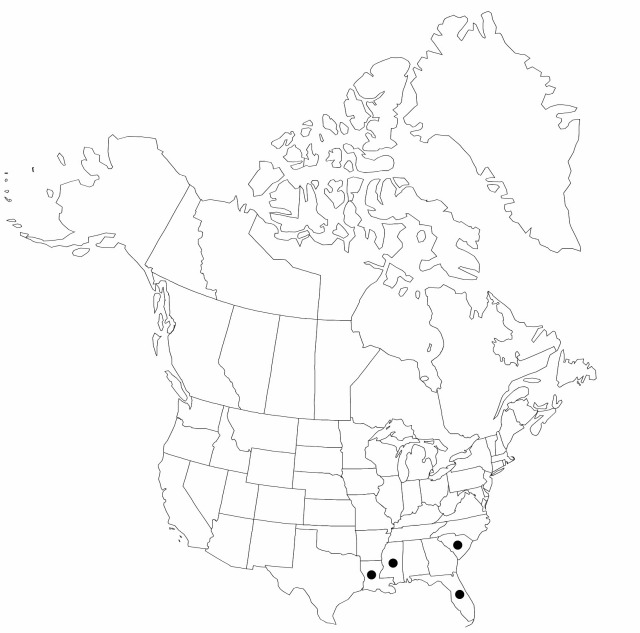Difference between revisions of "Cyperus pilosus"
Enum. Pl. 2: 354. 1805.
FNA>Volume Importer |
imported>Volume Importer |
||
| Line 8: | Line 8: | ||
}} | }} | ||
|common_names=Fuzzy flatsedge | |common_names=Fuzzy flatsedge | ||
| + | |special_status={{Treatment/ID/Special_status | ||
| + | |code=I | ||
| + | |label=Introduced | ||
| + | }}{{Treatment/ID/Special_status | ||
| + | |code=F | ||
| + | |label=Illustrated | ||
| + | }} | ||
|basionyms= | |basionyms= | ||
|synonyms= | |synonyms= | ||
| Line 24: | Line 31: | ||
|elevation=0–50 m | |elevation=0–50 m | ||
|distribution=Fla.;La.;Miss.;S.C.;Asia. | |distribution=Fla.;La.;Miss.;S.C.;Asia. | ||
| + | |introduced=true | ||
|discussion=<p><i>Cyperus pilosus</i> was naturalized in the flora from eastern Asia, apparently early in the twentieth century.</p><!-- | |discussion=<p><i>Cyperus pilosus</i> was naturalized in the flora from eastern Asia, apparently early in the twentieth century.</p><!-- | ||
--><p>The combination of hispidulous rachis and loosely oblong-ovoid spikes is sufficient to distinguish <i>Cyperus pilosus</i> from any others with deciduous floral scales.</p> | --><p>The combination of hispidulous rachis and loosely oblong-ovoid spikes is sufficient to distinguish <i>Cyperus pilosus</i> from any others with deciduous floral scales.</p> | ||
| Line 48: | Line 56: | ||
|publication title=Enum. Pl. | |publication title=Enum. Pl. | ||
|publication year=1805 | |publication year=1805 | ||
| − | |special status= | + | |special status=Introduced;Illustrated |
| − | |source xml=https:// | + | |source xml=https://bibilujan@bitbucket.org/aafc-mbb/fna-data-curation.git/src/bb6b7e3a7de7d3b7888a1ad48c7fd8f5c722d8d6/coarse_grained_fna_xml/V23/V23_269.xml |
|genus=Cyperus | |genus=Cyperus | ||
|subgenus=Cyperus subg. Cyperus | |subgenus=Cyperus subg. Cyperus | ||
Revision as of 21:32, 27 May 2020
Herbs, annual or perennial, cespitose; stolons slender, to 5 cm × 1.5 mm. Culms trigonous, 25–90 cm × 2 mm, hispidulous or glabrous on angles distally. Leaves flat, 10–35 cm × 3–10 mm. Inflorescences: spikes 1–4(–6), loosely oblong-ovoid, 2–3 × 1–2 cm; rays 3–10, 1–16 cm; 2d order rays to 3 cm; rachis hispidulous, prickles slender, 0.1–0.2 mm; bracts 3–5, ± ascending, flat, 5–35 cm × 0.5–5(–7) mm; rachilla persistent, wingless. Spikelets 15–40, linear-lanceoloid, compressed, 6–12 × 1.5–2 mm; floral scales deciduous, 8–16, light brown with clear border, laterally 2–3-ribbed, ovate, 1.8–2 × 1.2–1.6 mm; apex entire, emarginate, or mucronulate, mucro at most 0.3 mm. Flowers: anthers 0.4 mm; styles 0.6 mm; stigmas 1 mm. Achenes brown, sessile, broadly ellipsoid, 1–1.2 × 0.5 mm, apex obtuse, apiculate, surfaces puncticulate.
Phenology: Fruiting summer.
Habitat: Rice fields, wetlands, emergent muddy shores
Elevation: 0–50 m
Distribution

Introduced; Fla., La., Miss., S.C., Asia.
Discussion
Cyperus pilosus was naturalized in the flora from eastern Asia, apparently early in the twentieth century.
The combination of hispidulous rachis and loosely oblong-ovoid spikes is sufficient to distinguish Cyperus pilosus from any others with deciduous floral scales.
Selected References
None.
